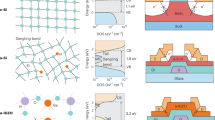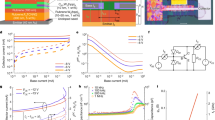Abstract
Thin-film transistors based on molecular and polymeric organic materials have been proposed for a number of applications, such as displays1,2,3 and radio-frequency identification tags4,5,6. The main factors motivating investigations of organic transistors are their lower cost and simpler packaging, relative to conventional inorganic electronics, and their compatibility with flexible substrates7,8. In most digital circuitry, minimal power dissipation and stability of performance against transistor parameter variations are crucial. In silicon-based microelectronics, these are achieved through the use of complementary logic—which incorporates both p- and n-type transistors—and it is therefore reasonable to suppose that adoption of such an approach with organic semiconductors will similarly result in reduced power dissipation, improved noise margins and greater operational stability. Complementary inverters and ring oscillators have already been reported9,10. Here we show that such an approach can realize much larger scales of integration (in the present case, up to 864 transistors per circuit) and operation speeds of ∼1 kHz in clocked sequential complementary circuits.





Similar content being viewed by others
References
Sirringhaus, H., Tessler, N. & Friend, R. H. Integrated optoelectronic devices based on conjugated polymers. Science 280, 1741–1744 (1998).
Dodabalapur, A. et al. Organic smart pixels. Appl. Phys. Lett. 73, 142–144 (1998).
Jackson, T. N. et al. Organic thin-film transistors for organic light-emitting flat-panel display backplanes. IEEE J. Spec. Topics. Quant. Electron. 4, 100–104 (1998).
Brown, A. R. et al. Logic gates made from polymer transistors and their use in ring oscillators. Science 270, 972–974 (1995).
Drury, C. et al. Low cost all-polymer integrated circuits. Appl. Phys. Lett. 73, 108–111 (1999).
Ziemelis, K. Putting it on plastic. Nature 394, 619–620 (1998).
Garnier, F. et al. Thin film transistors based on organic conjugated semiconductors. Chem. Phys. 227, 253–262 (1996).
Bao, Z. et al. High-performance plastic transistors fabricated by printing techniques. Chem. Mater. 9, 1299–1301 (1997).
Dodabalapur, A. et al. Complementary circuits with organic transistors. Appl. Phys. Lett. 69, 4227–4229 (1996).
Lin, Y.-Y. et al. Organic complementary ring oscillators. Appl. Phys. Lett. 74, 2714–2716 (1999).
Bao, Z., Lovinger, A. J. & Brown, J. New air-stable n-channel organic thin-film transistors. J. Am. Chem. Soc. 120, 207–208 (1998).
Dodabalapur, A., Torsi, L. & Katz, H. E. Organic transistors: two dimensional transport and improved electrical characteristics. Science 268, 270–271 (1995).
Katz, H. E., Torsi, L. & Dodabalapur, A. Synthesis, material properties and transistor performance of highly purified thiophene oligomers. Chem. Mater. 7, 2235–2237 (1995).
Filas, R. W. in Advances in Electronic Packaging Vol. 1, 1265–1282 (Am. Soc. Mech. Eng., New York, 1997).
Rabay, J. M. in Digital Integrated Circuits: A Design Perspective Ch. 6 (Prentice Hall, Upper Saddle River, New Jersey, 1996).
Dimitrakopoulos, C. et al. Low-voltage organic transistors on plastic comprising high dielectric constant gate insulators. Science 283, 822–824 (1999).
Dodabalapur, A., Katz, H. E., Torsi, L. & Haddon, R. C. Organic heterostructure field-effect transistors. Science 269, 1560–1562 (1995).
Dodabalapur, A., Baumbach, J., Baldwin, K. & Katz, H. E. Hybrid organic/inorganic complementary circuits. Appl. Phys. Lett. 68, 2246 (1996).
Bonse, M. et al. in IEDM Technical Digest 249–252 (Inst. Elect. Electron. Eng., Piscataway, New Jersey, USA, 1998).
Acknowledgements
We thank B. Batlogg, E. A. Chandross, A. J. Lovinger, J. H. O'Neill, M. Pinto, V. R. Raju, E. Reichmanis, J. Rogers, R. E. Slusher and P. Wiltzius for discussions.
Author information
Authors and Affiliations
Corresponding author
Rights and permissions
About this article
Cite this article
Crone, B., Dodabalapur, A., Lin, YY. et al. Large-scale complementary integrated circuits based on organic transistors. Nature 403, 521–523 (2000). https://doi.org/10.1038/35000530
Received:
Accepted:
Issue Date:
DOI: https://doi.org/10.1038/35000530
- Springer Nature Limited
This article is cited by
-
Elastic integrated electronics based on a stretchable n-type elastomer–semiconductor–elastomer stack
Nature Electronics (2023)
-
Integrated internal ion-gated organic electrochemical transistors for stand-alone conformable bioelectronics
Nature Materials (2023)
-
Electrostatically-sprayed carbon electrodes for high performance organic complementary circuits
Scientific Reports (2022)
-
A printed proximity-sensing surface based on organic pyroelectric sensors and organic thin-film transistor electronics
Nature Electronics (2022)
-
Electrochemical, EPR, and computational study of pyrene conjugates—precursors for novel type of organic semiconductors
Journal of Solid State Electrochemistry (2022)





